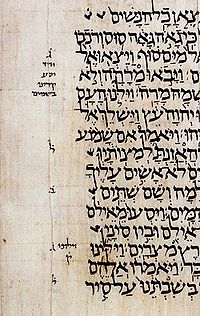Editor’s Note: Dr. Bartelt is responding to a New York Times editorial published on August 12, 2016, under the title, “Is God Transgender” He is author of Fundamental Hebrew Grammar and The Book around Immanuel: Style and Structure in Isaiah 2 – 12.
In all the discussion and debate over transgender issues, let’s at least get facts right. In his New York Times editorial, Rabbi Mark Sameth should know his historical Hebrew orthography better, certainly before making claims on biblical texts in the New York Times.
First, there is no evidence whatsoever for a “highly elastic view of gender” in the Hebrew of what we now call the Old Testament. The examples that Sameth cites are all cases of common spelling conventions, due not to elasticity in any “view of gender” but to some elasticity in the use of final vowels and how they were marked, both in the older consonantal texts and then also in the vocalized texts of the Hebrew scribal traditions.
The example of Gen. 3:12 is a very common case of the spelling and actual writing of letters (orthography) of the pronoun (and other words) from a time when the consonants that were used to mark long vowels were used for more than one letter. Not to get too technical, but the masculine pronoun hu’ and the feminine pronoun hi’ are spelled the same except for the long vowel in the middle, which came to be marked by a waw (“w,” for the vowel “u”) for the masculine pronoun and a yodh (“y” for the vowel “i”) for the feminine. Though the consonant “w” could be used for both in the ancient consonantal text (and both marks are small, similar signs, both in ancient and rabbinic script), the scribes have clearly indicated that the pronoun in Gen 3:12 is feminine.
As an aside, this variation is also part of the derivation of the divine name YHWH, from the verb h-y-h, even though the middle letter of that verbal root appears within the divine name as a “W” (waw) not “Y” (yodh). This spelling convention can be documented from countless examples that have nothing to do with actual gender issues, certainly not “gender elasticity.”
A similar phenomenon occurs in Gen 9:22. Here the consonant is a he (pronounced “hay”), which is well known as a marker of a final long vowel, especially in early orthography (see, inter alia, the classic study by David Noel Freedman and Frank Moore Cross, Early Hebrew Orthography: A Study of the Epigraphic Evidence). Most commonly the he indicates an “a” family vowel, which in this case would, indeed, mark the feminine pronominal suffix, “her.” But, in fact, and one that is well known to Hebrew scholars and documented from numerous examples, the same consonant can mark a final “o.” Again, the scribes have indicated that this is an “o” vowel, marking the suffix as “his” tent, not “hers.”
Further, Gen 24:16 is a bit of the reverse problem: the final consonant he that would mark the “a” of the feminine ending is missing, although the scribes have clearly marked the noun as feminine, thus “young woman,” not “young man” (which is what the noun would indicate without the feminine ending). The same thing happens earlier in v. 14, but all the other verbs and nouns in this entire narrative are consistent with the use of the feminine.
Gen 1:27 is a bit more interesting, as it goes to the heart of the matter itself, where “Adam” is used for “human being.” (The name is a pun on the Hebrew word for “earth,” or “ground,” the “’adamah” out of which the Adam was formed.) In Genesis 2, which is a second account of the creation event that focuses specifically on reproductive sexuality leading to the “next generation,” the details of how “God created them male and female in Gen 1:27 are provided. The “them” of this verse refers to the “male and female,” which turn out to be two, different, distinct but complementary genders in Gen 2. Gen 1:28 goes on to command the couple to “be fruitful and multiply,” and that cannot happen without a male and a female. The whole point of the account in Gen 2 is to show that “Adam” could not find a marriage partner without God making one who was “fit” for him (Gen 2:18, the Hebrew preposition means “opposite,” “appropriate,” “suitable,” “complementary”), and the concept of how male and female “fit together” includes also the sexual physiology that is fundamental to one’s sexual identity.
It is a basic principle of biblical interpretation to interpret the unclear in light of the clear, and this applies also to grammatical oddities and spelling conventions. To assert that the Hebrew Bible supports “gender elasticity” by using examples such as these, and even misunderstanding the grammatical facts that remove the very argument Rabbi Sameth is trying to make out of thin air, is not only bad method but, more importantly, ignores the preponderance of clear biblical evidence that gender is unique and distinct, male and female.
Grasping at straws can hardly be considered credible argumentation, especially for the New York Times.


Leave a Reply
You must be logged in to post a comment.